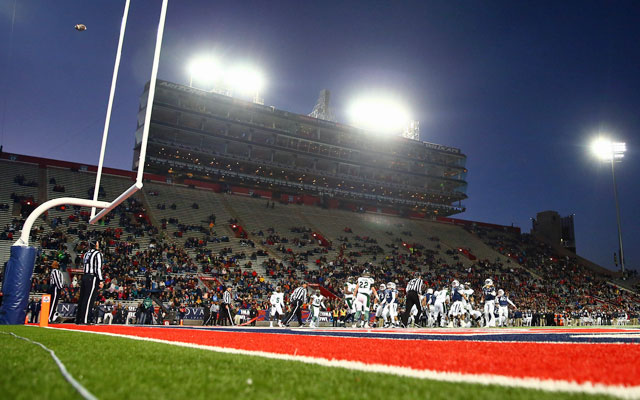Lance Aldridge badly wants a college football bowl game for Austin, Texas, in 2016. “We’re trying,” said Aldridge, executive director of the Austin Sports Commission. “We’re trying every way possible.
Big 12 commissioner Bob Bowlsby desperately wants to stop new bowl games from being created. “If you have any ideas, I’m all ears,” said Bowlsby, who’s chairing an NCAA working group examining the proliferation of bowls.
Welcome to the annual offseason edition of, “How many bowl games are too many?” Only this time, there’s heightened frustration after last season, the first with 40 bowls.
Bowls needed three 5-7 teams to receive waivers to fill slots since there weren’t enough 6-6 teams. Chaos ensued over how to choose and place those teams. One bowl featured two Mountain West Conference teams. It was enough for MWC commissioner Craig Thompson to declare the bowl system “broken.” And yet cities keep wanting bowls.
Austin and Charleston, South Carolina, are interested in 2016 games. Myrtle Beach, South Carolina, is eyeing a bowl in the future. Little Rock, Arkansas has called it quits trying to land a bowl, believing the current system is too risky.
The problem has been years in the making. First, major conferences added bowl tie-ins so every 6-6 team could make a game. Then smaller conferences created bowls so they could have more slots, too. And the NCAA kept certifying bowl after bowl after bowl.
“It’s a double-edged sword,” said Bowlsby, whose conference didn’t fill all of its bowl spots in 2015. “If we don’t go down far enough to make sure all of our schools find a postseason home, then the smaller conferences backfill behind us and we have eligible teams that get left home. Everybody is acting in their own self-interests, and I don’t think our committee is charged with solving all of the problems of the postseason.”
In 1997, 35 percent of major college football teams (then known as Division I-A) participated in 20 bowls. By 2015, 63 percent of the Football Bowl Subdivision played in 41 bowls.
Supporters of more bowls argue, “So what?” They point to teams with losing records making the NCAA men’s basketball tournament. Then again, if 63 percent of Division I basketball reached the sport’s main postseason, there would be a field of 221 teams in the NCAA Tournament.
As more bowls got added, an argument could be made that the quality of the postseason as a whole has become watered down. The past six years produced the three most lopsided bowl seasons since 1998. Bowls were decided by 15.8 points per game last season, the highest in 18 years.
“If we decide 7-5 (for bowl eligibility), that’s fine. If we decide 6-6, that’s fine,” Bowlsby said. “I don’t think there ought to be a waiver process. At what point are we going to be putting 4-8 teams out there? If we continue to have more bowls, at some point in time there’s a mathematical impossibility of enough teams with a winning record being there.”
The bowl working group has just gotten started and doesn’t have answers yet. The main issues being studied: bowl-eligibility record, how the finances work for different bowls, the selection processes for games, and requiring as much as possible a uniform experience for each bowl.
Also on the working group: Arizona State athletic director Ray Anderson; Penn State athletic director Sandy Barbour; Mountain West deputy commissioner Brett Gilliland; Tulsa athletic director Derrick Gragg; Miami athletic director Blake James; Georgia athletic director Greg McGarity; Conference USA commissioner Judy McLeod; MAC commissioner Jon Steinbrecher; and South Alabama kicker Aleem Sunanon.
Bowl directors for the Alamo Bowl and Famous Idaho Potato Bowl and Football Bowl Association (FBA) executive director Wright Waters are advising the group, which will make recommendations to the NCAA Council.
There are legal considerations for the NCAA, which certifies bowls but basically has no other role in the FBS postseason. In 2004, the National Invitational Tournament sued the NCAA, saying it violated antitrust law by requiring teams to play in the NCAA Tournament if they are invited. The NCAA ended the case by buying the NIT for $40.5 million and paying another $16 million to settle.
“Part of this is if you start to limit who can have a bowl, you start having accusations of restraint of trade again,” Bowlsby said. “Down the road, maybe the FBA can do some self-regulation that the NCAA can’t do. Right now, it’s a lot simpler deciding who is eligible to play in a bowl.”
In the meantime, new bowls wait.
“We’re moving forward this year with the assumption we’re going to be OK,” said Tommy McQueeney, chairman of Charleston’s Medal of Honor Bowl, which hopes to have an ACC tie-in. “But that task force is probably going to determine where we are.”
NCAA bowl requirements are ‘watered down’
There used to be tighter requirements for NCAA bowl certification. A decade ago, a bowl needed a $2 million line of credit and to average 25,000 fans over three years to remain certified. Today, the standards have gotten “watered down,” Bowlsby said.
“It doesn’t even require a TV contract,” he said. “You basically just have to have two willing parties and a city willing to host.”
Aldridge said Austin is a willing city with a stadium at the University of Texas and just needs conferences. When he interviewed for executive director of the Austin Sports Commission, one obvious question asked of him is what events he can bring to Austin.
So on his first day on the job, Aldridge began making calls to try to land a bowl. Austin was one of three new bowls the NCAA certified last year, but the city decided it was better off waiting until 2016.
“We read the papers and there’s always talk of the financial viability of some of the existing games,” Aldridge said. “Maybe in a roundabout way that could work in our favor with some potential conference tie-ins.”
Translation: Austin hopes one or two current bowls die so there are available conference tie-ins. Many people within the bowl industry believe it’s only a matter of time before the system contracts.
A key question is if ESPN, which televises most of the bowls and owns 13 outright, thinks the programming continues to be valuable. Bowls used to be largely about tourism for cities during the down time of the holidays. Now they’re mostly about cheap programming that draws better ratings than almost anything else ESPN could air in December.
Finances for individual bowls are all over the map. For instance, tax records show the Foster Farms Bowl lost a combined $1.3 million on its games from 2012-14 and net assets decreased to minus-$769,619 by 2015. The game, previously called the Kraft Fight Hunger Bowl and held in San Francisco and Santa Clara, had matchups those years of Navy-Arizona State, BYU-Washington and Maryland-Stanford.
The bowl’s revenue from ticket sales and TV rights increased over that period, but so did the costs. The payout to schools doubled to $3.6 million.
The Independence Bowl, which has existed since 1976, has also faced financial concerns. In 2011-12, the Independence’s net assets were minus-$466,746, according to tax records. By 2013-14, the most recent tax form available online, the bowl’s net assets were $72,400. Some help will come from a hotel occupancy tax passed in November that will benefit the bowl. Still, the Independence is searching for stability with a title sponsor.
AdvoCare pulled out as the title sponsor in 2013, and the Independence lost $530,405 on Arizona-Boston College that season. The 2014 game was played without a contract with Duck Commander, just a letter of intent as title sponsor. The relationship ended with the Independence short about half a million dollars from what it used to receive from a title sponsor. Camping World is now the game’s title sponsor.
Public money helps fill in financial gaps for some bowls. The city of Birmingham now pays $500,000 a year for the ESPN-owned Birmingham Bowl, up $200,000 from its typical distribution, became the game hasn't had a title sponsor the past two years.
Last season, the Independence’s announced crowd was down 18 percent for Virginia Tech-Tulsa and was the game’s smallest since 1988. Attendance for UCLA-Nebraska at Foster Farms, featuring the 5-7 Cornhuskers, was down 4 percent and was the bowl’s second-smallest crowd in eight years. The Birmingham Bowl was up 98 percent in attendance this season for Auburn-Memphis.
| Bowl Game Finances | |||
| Bowl organization | Net assets | Bowl director pay | Reporting year |
| Sugar Bowl | $64.9 million | $753,546 | 2013-14 |
| Orange Bowl Committee Inc. | $51.8 million | $783,380 | 2013-14 |
| Arizona Sports Foundation (Fiesta) | $50.6 million | $589,645 | 2013-14 |
| Pasadena Tournament of Roses Assoc. | $33.8 million | $365,141 | 2013-14 |
| Peach Bowl Inc. | $24.1 million | $652,854 | 2013-14 |
| Cotton Bowl Athletic Assoc. | $19.3 million | $994,065 | 2014-15 |
| San Antonio Bowl Assoc. Inc. (Alamo) | $16.9 million | $578,216 | 2014-15 |
| Florida Citrus Sports Assoc. | $8.8 million | $424,624 | 2013-14 |
| Tampa Bay Bowl Assoc. Inc. (Outback) | $5.0 million | $831,145 | 2013-14 |
| San Diego Bowl Assoc. (Holiday, Poinsettia) | $4.3 million | $343,718 | 2014-15 |
| Gator Bowl Sports Inc. | $3.8 million | $402,174 | 2013-14 |
| Liberty Bowl Festival Assoc. | $2.0 million | Not listed | 2014-15 |
| Tangerine Sports Assoc. Inc. (Russell Athletic) | $1.6 million | $424,624 | 2013-14 |
| New Orleans Bowl Inc. | $1.5 million | Not listed | 2012-13 |
| Music City Bowl Inc. | $1.1 million | $395,514 | 2013-14 |
| Sun Bowl Assoc. | $950,367 | $179,214 | 2014-15 |
| DC Bowl Committee Inc. (Military) | $399,750 | $257,722 | 2014-15 |
| Humanitarian Bowl Inc.* (Potato) | $201,727 | $120,000 | 2012-13 |
| Mobile Alabama Bowl Inc. (Go Daddy) | $140,734 | $100,000 | 2014-15 |
| Independence Bowl Foundation | $72,400 | $117,494 | 2013-14 |
| San Francisco Bowl Game Assoc. (Foster Farms) | ($769,619) | $315,121 | 2014-15 |
| * Potato Bowl was purchased by ESPN in 2013. Source: 990 Tax Forms on Guidestar.com; not available for privately-owned bowls. |
|||
With Confederate flag down, South Carolina wants a bowl
The choppy waters aren’t stopping some cities’ interest in bowls. Two coastal cities in South Carolina eye bowl games to obtain exposure and revenue they haven’t been able to get for 15 years.
Last July, the Confederate flag was removed from Statehouse grounds in South Carolina. The NCAA lifted its boycott on staging predetermined championship sites in the state, including bowl games. Charleston ran into Confederate flag roadblocks in 2005 -- for the proposed Palmetto Bowl -- that are no longer there.
Back then, Charleston also had an issue with stadium size at The Citadel, said McQueeney, who is leading the city’s bowl efforts. Since then, The Citadel’s stadium expanded to 21,000 after a $42 million renovation and more seats can be added if necessary.
“I looked at a bowl as reason to complete the stadium, and we’ve done that,” McQueeney said. “I think we’re in pretty good shape because of the novelty. The state of South Carolina has never had a bowl game. Myself and the committee are asked all the time, ‘What’s happening with the bowl?’ Because of the size of the stadium and we’re the new kid on the block, we’d be lucky to get a 7-5 team. But it’s going to be a win-win.”
Myrtle Beach also has interest in adding a bowl at Coastal Carolina, but nothing is imminent, said Brad Dean, president and CEO of the Myrtle Beach Chamber of Commerce. Coastal Carolina will be moving to the Sun Belt Conference and Myrtle Beach wants to create more of an identity as a national tourist destination.
“If you have to have 40 games and there’s so much focus on the college playoffs, 40 might scare away sponsors, but that remains to be seen,” Dean said. “We think at some point we can play a role in that. It’s at least a couple years off.”
Last year, Little Rock, Arkansas withdrew its application to host a 2015 bowl and planned to pursue a game this year. That’s not happening, not after how Little Rock views the bowl system.
Kevin Crass, chairman of the War Memorial Stadium Commission, said Little Rock had a TV contract and agreements with the Sun Belt and American Athletic Conference last year. But he said he grew concerned when a Liberty Bowl official called in a panic because the Sun Belt was the Liberty’s backup conference if it needed a bowl-eligible team.
“This is when I realized how tenuous this is,” Crass said. “He said, ‘What does your contract say?’ I said, ‘I’m not telling you what my contract says.’ He was right, but I wasn’t going to admit he’s entitled to a Sun Belt team before me.”
Conference ticket sales planned to be 25 percent of the bowl budget for Little Rock, which was negotiating for a title sponsor but hadn’t finalized a deal. Crass decided it was too risky if he might need to go on the open market for a team and revenue to replace the Sun Belt or AAC.
“It’s unfortunate because the community was excited about it,” Crass said. “I get asked about it all the time in town. ‘When’s the bowl coming?’ I went into the process saying there are too many bowls, and I came out of the process knowing there are too many bowls.”
Follow and read more from Jon Solomon on Facebook and Twitter.





















